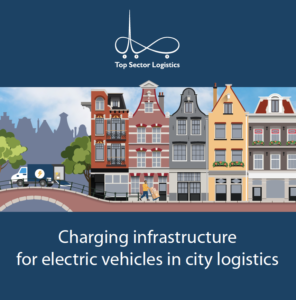There is a major role for electric mobility in the Dutch Climate Agreement presented in June 2019. Almost 12 percent of CO2 emissions are produced by road transport, and 30 to 35 percent of the CO2 emissions in road transport are related to city logistics. The Dutch Climate Agreement states that road transport must reduce CO2 emissions in city logistics by 1 Mt by 2050.
Zero-emission zones will be created in 30 to 40 Dutch cities, including the city of Amsterdam. Amsterdam is working on a ‘Clean Air’ action plan and a program to restrict traffic in the city (city logistics is part of this).
Over the next 10 years, an increasing number of battery electric vehicles (BEVs) and plug-in hybrid electric vehicles (PHEVs) will appear on the roads to comply with the zero-emission requirements. For companies delivering or collecting goods in the city, the challenge is not only moving to zero-emission vehicles but also minimizing the number of delivery vans and trucks that enter the zero-emission zone. Walking, cycling and public transport have priority in urban mobility.
City logistics is not only about supplying shops, offices, and construction sites, delivering parcels to consumers and companies, delivery vans of service companies, removal companies, but it is also about local shops, caterers and florists who deliver to their customers.
What charging infrastructure is needed for zero-emission city logistics?
Electric vehicles require charging stations for recharging batteries in the right locations and with the right capacity. Goods transport has different requirements for the charging infrastructure than passenger mobility.
The large-scale use of BEVs and PHEVs gives rise to questions, such as: Does the grid have enough capacity? How and where will companies be charging their vehicles in the future? Are there enough charging points in the right locations? What investments are required? Should the power grid be modified for zero-emission 2025, and thereafter? Can the demand be covered by the public charging infrastructure, or should companies install private charging stations?
The Dutch Topsector Logistics has asked experts and knowledge institutes to investigate these questions for the Amsterdam region. The approach can, however, be applied anywhere.
Results and insights
From an operational perspective (based on their journey profiles), zero-emission light commercial vehicles today are feasible for e-commerce, e-groceries, delivery of fresh produce, facility products, catering and parts of construction logistics. Supermarket and retail deliveries and construction logistics with larger BEV trucks from national distribution centers are feasible after 2028. The choices businesses make are different for different city logistics segments. The research also shows that companies investing in BEVs should also revise their working methods and not simply purchase electric versions of the same vehicles they have today.
The total electric power demand of ZE city logistics is relatively compared to other energy users. It is easier to predict peaks in power demand, both geographically and over time. A peak can have major consequences locally, as this small additional peak could just push the overall demand over a critical limit. Smart charging is necessary. Expansion of the grid capacity at a specific location can take several years.
Where will the ZE vehicles be charged?
In the Amsterdam Metropolitan Area, more than 90 percent of electric delivery vans going into the future zero-emission zone come from outside Amsterdam. About 60 percent are parked in residential areas at night and are charged at private or public charging stations.
There are four possible locations where vehicles can be charged: the charging infrastructure available at companies, in the public space (including public charging infrastructure around building sites), at the destination on the customer’s premises and at the homes of the employees. Based on trip profiles, a calculation model was used to determine the best charging strategy. The calculation model includes the costs of electricity and the charging infrastructure. The calculation model recognizes different types of delivery vans and trucks. The best charging strategy (from a cost perspective) depends on the type of vehicle and the capacity of the battery, the trip profile, and the associated charging strategy. If the charging costs and the costs of waiting while charging are included, the solution will result in the lowest costs.
In the case of Amsterdam 40,000 charging sessions are expected each day. More than 90% for light commercial vehicles. The largest share of demand for electricity for charging occurs at business locations and depots (usually on industrial parks). The largest number of charging stations is needed for delivery vans parked in residential areas (at night). Charging at customer sites represents 16% of the charging demand for trucks and 6% for delivery vans at supermarkets, distribution centers, construction sites and at offices. Public and fast charging is expensive compared to having own charging infrastructure or recharging at depots and/or customers.
The effect of energy tax and the energy rate structure (the cost per kWh) for bulk users versus small users is big. If this rate structure were to change in the future, this would have major consequences for the charging strategies. For the time being, the cheapest option is private charging at locations where ‘wholesale’ energy rates apply and where there are enough charging stations. Fast charging at public charging stations is a ‘last resort’.
The additional power demand for zero-emission vehicles in city logistics is limited; the additional power demand in Amsterdam is 0.25% of the total power demand at peak times. Bottlenecks may, however, occur when the maximum capacity of the local grid has reached. Increasing the capacity may take considerable time and costs.

